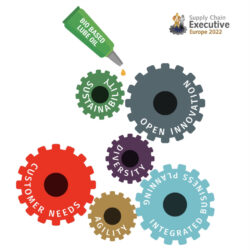Top 28 Supply Chain Executives: storytelling increasingly important

What are the key trends and themes in supply chain? And what skills do supply chain executives need for this? Numbers 2 and 3 from the Top 28 Supply Chain Executives, Paul Campbell of PepsiCo and Frederic Brut of MSD, give their views in a webinar by Supply Chain Media, IG&H and Inspired-Search. ”Sustainability is not only a challenge for the supply chain, but for the whole company.”
By Marcel te Lindert
Sustainability and digitalisation are still the two trends with the biggest impact on business operations. That is according to new research by Supply Chain Media among supply chain executives, which shows almost the same picture as previous surveys in 2020 and 2022. Paul Campbell (pictured, right) questions whether all the focus on digitalisation is a temporary phenomenon or a serious issue. ”You often see that the things everyone is talking about are also considered the most important, when in reality that does not have to be the case. Take artificial intelligence. The standard statement is that ‘we have to do something with that’. Whereas the question should be whether companies have a problem for which artificial intelligence offers a solution,” says the senior vice president supply chain Europe at PepsiCo.
Frederic Brut (pictured, left) had expected reshoring to be higher on the list. ”We are coming from a centralised production model in the US and Europe and moving to a more decentralised production model. That includes packaging products in locations closer to customers and optimising costs with the right mix of high-cost and low-cost locations. We started working on this issue within MSD three or four years ago. Decentralisation contributes to our goal of helping our patients as quickly as possible by improving access to medicines.”
The role of supply chain in sustainability
That sustainability is at the top of the list does not surprise either executive at all. Both PepsiCo and MSD have made sustainability a company policy. They are somewhat more doubtful about the statement that they themselves, as supply chain executives, should be at the forefront of this. Host Martijn Lofvers points to Ewan Andrew, number 1 in the Top 28 Supply Chain Executives, who unfortunately could not participate in the webinar. Within beverage producer Diageo, Ewan is responsible at the highest level for both supply chain and sustainability. ”From his position, he decided last year to stop gift packaging because of all the extra packaging materials,” Lofvers knows.
”It is true that a large part of CO2 emissions are in the supply chain,” agrees Campbell. ”But to reduce them, the whole organisation has to change. Going back to that example of packaging: I can decide to introduce renewable packaging, but if that changes the proposition to customers or the shelf life of products, it poses new challenges for the whole company. This is why we made a conscious decision to have our sustainability manager no longer report to me, but directly to the CEO. Sustainability is a challenge for the whole company.”
Low score for talent management
MSD has also made someone at the top responsible for sustainability, but that person’s main task is to connect all divisions and departments within the company. ”But as executives, we all have our own responsibilities and KPIs in this area, think about reducing air freight and scope 3 emissions in our supply chain,” states Brut. This is also the approach advocated by Oskar Verkamman of Inspired-Search, the recruitment agency that contributed to the composition of the Top 28. ”If you make one person at the top responsible for sustainability, there is a danger that the rest will sit back. In my opinion, sustainability should be part of everyone’s goals and targets.”
When asked what are currently the two most important topics of discussion at the board table, digitalisation scores high, as do operational excellence and cost reduction. Both themes are related, says Jasper van Rijn of IG&H, which also collaborated on the creation of the Top 28. ”Digitalisation helps to reduce costs. We see many companies digitising their processes to become more cost-efficient. At the same time, I think we are only at the beginning when it comes to digitisation and automation. Most companies’ ambitions extend far beyond the position where they are today.”
Managing the talent pipeline
The subject of talent & change management (10%) scored remarkably low. ”That surprises me,” states Brut. ”Talent management and change management should be part of the DNA of supply chain executives. This is a topic that deserves daily attention. Look at the crucial roles our employees play. Talent development and the like is necessary to equip these employees with the skills they need to excel.”
In terms of talent management, shouldn’t supply chain executives play a more prominent role? They can use their knowledge to manage the talent pipeline as a supply chain and help solve bottlenecks. ”I agree with that in many ways,” Campbell argues. ”Talent pipeline management is a process. And we supply chain executives specialise in processes. Within PepsiCo, we have developed some tools in recent years that help us do that. Those tools help identify which way we should go with our people. Those come partly from the work we have done on supply chain diagnostics.”
Importance of storytelling
Verkamman notes that talent management has become synonymous with recruiting. ”But recruitment is just one element of talent management. It is also about planning, maintaining and developing the overall workforce. Responsibility for this should lie in the department, including the supply chain executive,” the recruiter argues, adding that talent management will remain a key focus in the future as well. ”Figures show that the labour market in Europe will decline by 20% over the next 25 years. So we will continue to face talent shortages for decades to come.”
The last question is about the skills supply chain executives need. Interestingly, storytelling & change management scored highest at over 40%, more than twice as much as last year. ”If you take a step back, it’s actually quite logical. Crucial in managing change, is the ability to bring people with you, especially in these volatile and uncertain times. It helps better to tell a story than to lose people in details about the complexities of the supply chain. If we are touched by the story, we can bind them to us.”










